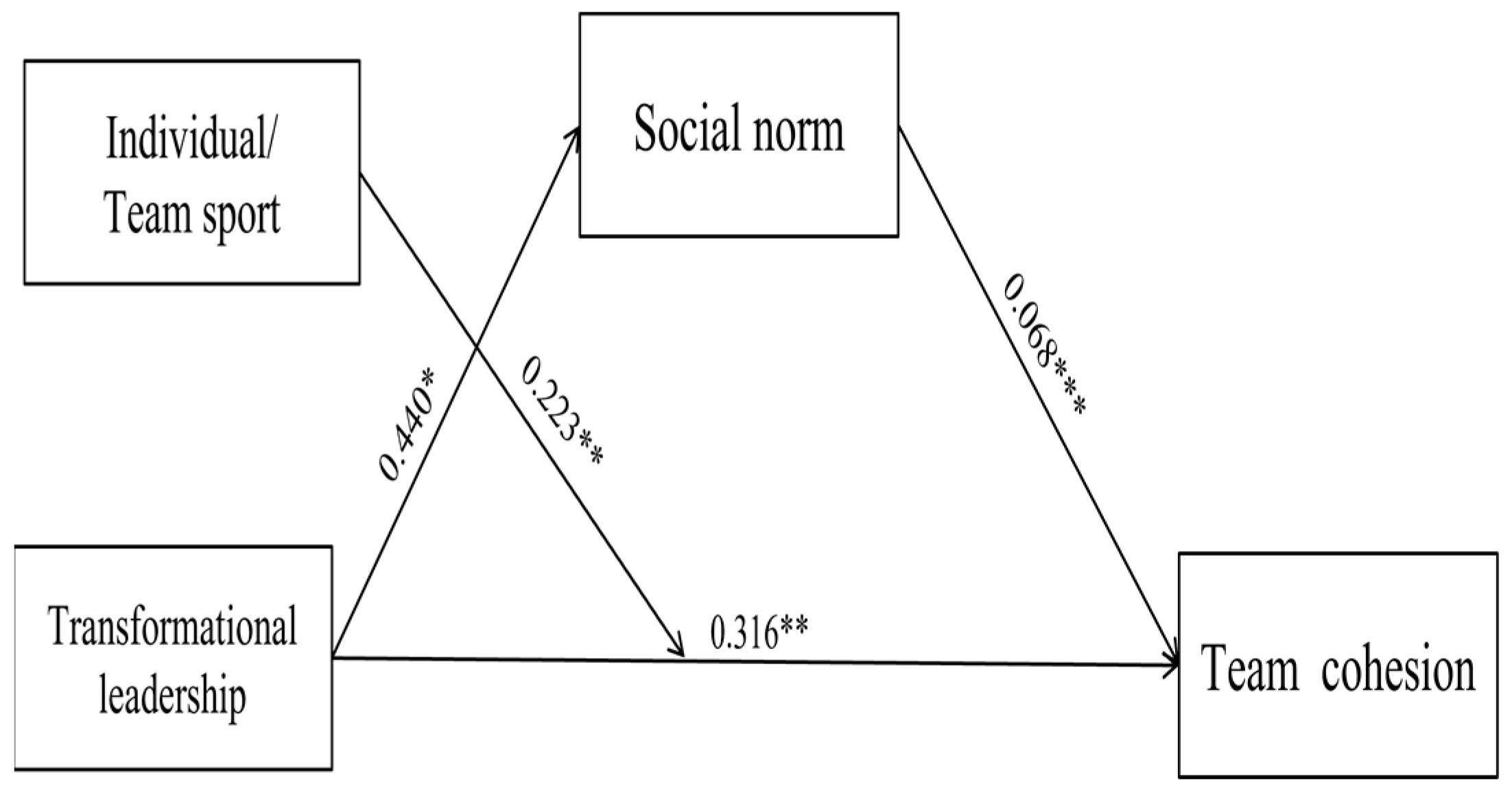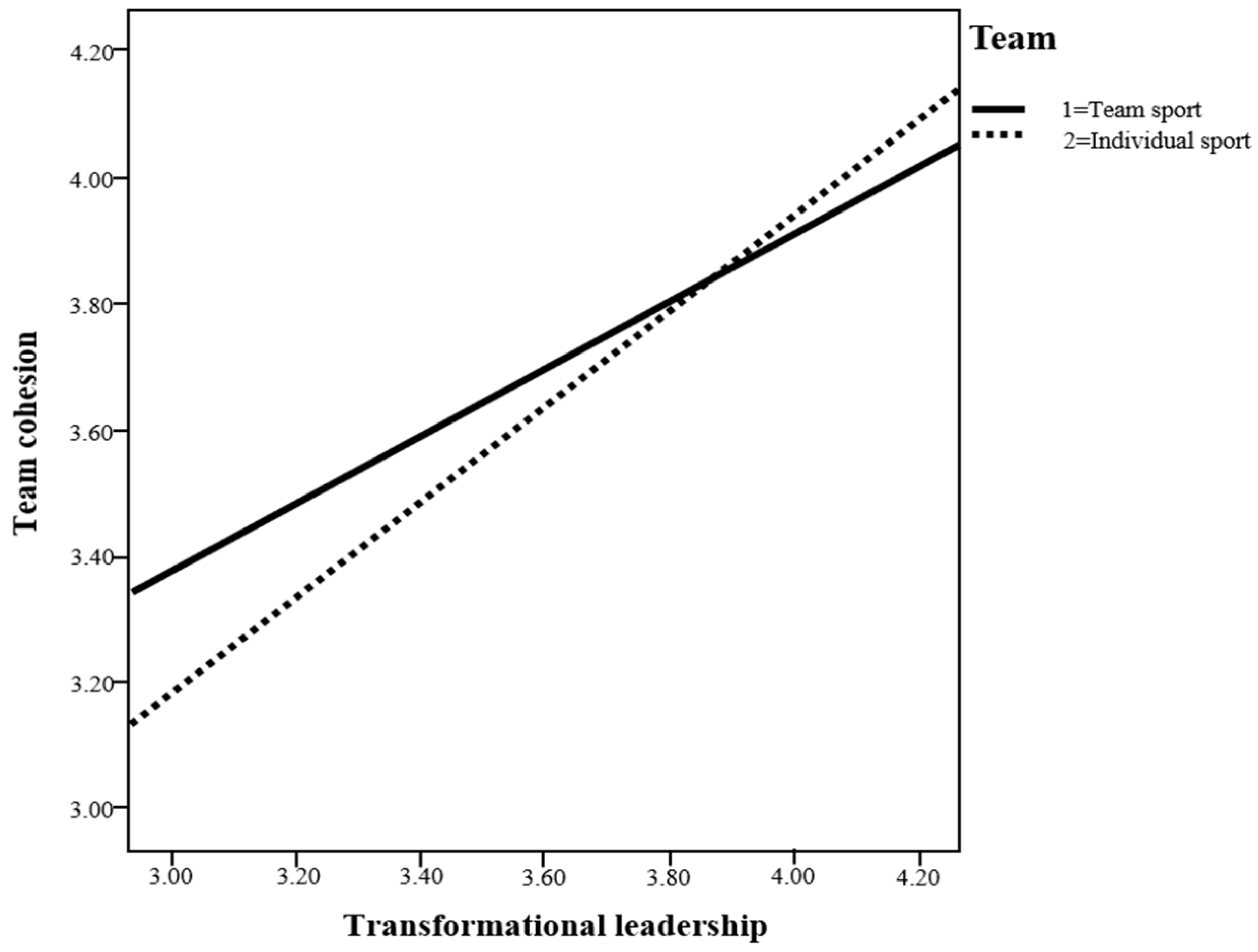Cohesión de equipo en atletas de deportes individuales/de equipo: liderazgo transformacional y el papel de las normas sociales

Youngtaek Oh y Jung-In Yoo
La cohesión del equipo es un factor crítico en los deportes, sin embargo, pocos estudios han analizado comparativamente a los atletas de deportes individuales y de equipo en situaciones deportivas. El propósito de este estudio fue identificar la relación entre el liderazgo transformacional, las normas sociales y la cohesión del equipo, y analizar los efectos moderadores de los atletas de deportes individuales/de equipo. En 2022, un total de 196 jugadores de béisbol, judo, fútbol, taekwondo y hockey registrados en el Comité Olímpico y Deportivo de Corea completaron un cuestionario utilizando escalas de liderazgo transformacional, normas sociales y cohesión de equipo. El liderazgo transformacional tuvo un efecto positivo significativo en las normas sociales y la cohesión del equipo. Las normas sociales tuvieron un efecto positivo significativo en la cohesión del equipo. El liderazgo transformacional y la interacción de atletas deportivos individuales/de equipo tuvieron un efecto significativo en la cohesión del equipo. En este momento, los atletas de deportes individuales parecían tener una cohesión de equipo algo mayor. Este estudio arroja luz sobre las normas sociales y la cohesión del equipo de los atletas desde una perspectiva moral social basada en la teoría del liderazgo transformacional. También puede ayudar a los jóvenes deportistas que recién comienzan a aprender la cultura y la sociología del deporte.


Referencias
- Onağ, Z.; Tepeci, M. Team effectiveness in sport teams: The effects of team cohesion, intra team communication and team norms on team member satisfaction and intent to remain. Procedia-Soc. Behav. Sci. 2014, 150, 420–428. [Google Scholar] [CrossRef]
- Brisimis, E.; Bebetsos, E.; Krommidas, C. Does group cohesion predict team sport athletes’ satisfaction. Hell. J. Psychol. 2018, 15, 108–124. [Google Scholar]
- Bass, B.M. Two decades of research and development in transformational leadership. Eur. J. Work Organ. Psychol. 1999, 8, 9–32. [Google Scholar] [CrossRef]
- Smith, M.J.; Arthur, C.A.; Hardy, J.; Callow, N.; Williams, D. Transformational leadership and task cohesion in sport: The mediating role of intrateam communication. Psychol. Sport Exerc. 2013, 14, 249–257. [Google Scholar] [CrossRef]
- Fstinger, L.; Schachter, S.; Back, K. Social Pressures in Informal Groups; Stanford University Press: Stanford, CA, USA, 1950. [Google Scholar]
- Carron, A.V.; Brawley, L.R.; Widmeyer, W.N. The Measurement of Cohesiveness in Sport Groups. 1998. Available online: profiles.citeready.com (accessed on 3 February 2023).
- Carron, A.V.; Burke, S.M.; Shapcott, K.M. Enhancing Team Effectiveness; Brewer, B.W., Ed.; International Olympic Committee Medical Commission handbook of sports medicine and science, Sport psychology; Wiley-Blackwell Publishing, Ltd.: Oxford, UK, 2009. [Google Scholar]
- Black, J.; Kim, K.; Rhee, S.; Wang, K.; Sakchutchawan, S. Self-efficacy and emotional intelligence: Influencing team cohesion to enhance team performance. Team Perform. Manag. Int. J. 2018, 25, 100–119. [Google Scholar] [CrossRef]
- Sullivan, P.J.; Short, S. Further operationalization of intra-team communication in sports: An updated version of the Scale of Effective Communication in Team Sports (SECTS-2). J. Appl. Soc. Psychol. 2011, 41, 471–487. [Google Scholar] [CrossRef]
- MacKinnon, D.P.; Fairchild, A.J.; Fritz, M.S. Mediation analysis. Annu. Rev. Psychol. 2007, 58, 593. [Google Scholar] [CrossRef]
- Givens, R.J. Transformational leadership: The impact on organizational and personal outcomes. Emerg. Leadersh. Journeys 2008, 1, 4–24. [Google Scholar]
- Bums, J.M. Leadership; Harper & Row: New York, NY, USA, 1978. [Google Scholar]
- Bass, B.M. Leadership and Performance Beyond Expectations; The Free Press: New York, NY, USA, 1985. [Google Scholar]
- Bass, B.M. Transformational Leadership: Industrial, Military, and Educational Impact; Lawrence Erlbaum Associates: Mahwah, NJ, USA, 1998. [Google Scholar]
- Avolio, B.J.; Bass, B.M. Transformational leadership, charisma, and beyond. In Emerging Leadership Vitas; Hunt, J.G., Baliga, B.R., Dachler, H.P., Schriesheim, C.A., Eds.; Lexington Books: Lexington, MA, USA, 1988; pp. 29–49. [Google Scholar]
- Bennis, W.G.; Nanus, B. Leaders: The Strategies for Taking Charge; Harper & Row: New York, NY, USA, 1985. [Google Scholar]
- Bass, B.M.; Avolio, B.J. Improving Organizational Effectiveness through Transformational Leadership; Sage: Thousand Oaks, CA, USA, 1994. [Google Scholar]
- Krishnan, V.R. Transformational leadership and outcomes: Role of relationship duration. Leadersh. Organ. J. 2005, 26, 442–457. [Google Scholar] [CrossRef]
- Bass, B.M.; Riggio, R.E. Transformational Leadership; Psychology Press: London, UK, 2006. [Google Scholar]
- Price, M.S.; Weiss, M.R. Relationships among coach leadership, peer leadership, and adolescent athletes’ psychosocial and team outcomes: A test of transformational leadership theory. J. Appl. Sport Psychol. 2013, 25, 265–279. [Google Scholar] [CrossRef]
- Schaubroeck, J.; Lam, S.S.; Cha, S.E. Embracing transformational leadership: Team values and the impact of leader behavior on team performance. J. Appl. Psychol. 2007, 92, 1020. [Google Scholar] [CrossRef]
- Stenling, A.; Tafvelin, S. Transformational leadership and well-being in sports: The mediating role of need satisfaction. J. Appl. Sport Psychol. 2014, 26, 182–196. [Google Scholar] [CrossRef]
- Baird, N.; Martin, L.J.; Benson, A.J. A dynamic view of coach transformational leadership: How leadership perceptions relate to task cohesion and team potency. Psychol. Sport Exerc. 2020, 51, 101789. [Google Scholar] [CrossRef]
- Callow, N.; Smith, M.J.; Hardy, L.; Arthur, C.A.; Hardy, J. Measurement of transformational leadership and its relationship with team cohesion and performance level. J. Appl. Sport Psychol. 2009, 21, 395–412. [Google Scholar] [CrossRef]
- Chan, S.C.; Mak, W.M. Transformational leadership, pride in being a follower of the leader and organizational commitment. Leadersh. Organ. Dev. J. 2014, 35, 674–690. [Google Scholar] [CrossRef]
- Burke, S.M.; Carron, A.V.; Shapcott, K.M. Cohesion in exercise groups: An overview. Int. Rev. Sport Exerc. Psychol. 2008, 1, 107–123. [Google Scholar] [CrossRef]
- Carron, A.V.; Colman, M.M.; Wheeler, J.; Stevens, D. Cohesion and performance in sport: A meta analysis. J. Sport Exerc. Psychol. 2002, 24, 168–188. [Google Scholar] [CrossRef]
- Mills, J.P.; Boardley, I.D. Expert Premier League soccer managers’ use of transformational leadership behaviours and attitude towards sport integrity: An intrinsic case study. Int. J. Sport. Sci. Coach. 2016, 11, 382–394. [Google Scholar] [CrossRef]
- Newland, A.; Newton, M.; Moore, E.W.G.; Legg, W.E. Transformational leadership and positive youth development in basketball. Int. Sport Coach. J. 2019, 6, 30–41. [Google Scholar] [CrossRef]
- Cevahircioglu, B.; Şenel, E.; Karakus, K. The Determined of Relationship Between Team Cohesion and Effective Communication Skill Levels in Volleyball Players. Turk. J. Sport Exerc. 2022, 24, 122–131. [Google Scholar]
- Gomes, A.R.; Lopes, H.; Mata, R.T. Leadership, cohesion and satisfaction: Differences between swimming and handball Portuguese teams. Rev. Mex. Psicol. 2011, 28, 31–42. [Google Scholar]
- Kim, J.J.; Oh, Y.T. The Relationship between Transformational Leadership Perceived by Kumdo·Taekwondo Athletic and Athletic Performance Assessment: Verification of Mediating Effect of Conflict Management. J. Korean Alliance Martial Arts 2022, 24, 1–14. [Google Scholar]
- Bruner, M.W.; Eys, M.A.; Wilson, K.S.; Côté, J. Group cohesion and positive youth development in team sport athletes. Sport Exerc. Perform. Psychol. 2014, 3, 219–227. [Google Scholar] [CrossRef]
- Kao, S.F.; Tsai, C.Y.; Schinke, R.; Watson, J.C. A cross-level moderating effect of team trust on the relationship between transformational leadership and cohesion. J. Sport. Sci. 2019, 37, 2844–2852. [Google Scholar] [CrossRef] [PubMed]
- Bass, B.M.; Avolio, B.J.; Jung, D.I.; Berson, Y. Predicting unit performance by assessing transformational and transactional leadership. J. Appl. Psychol. 2003, 88, 207–218. [Google Scholar] [CrossRef] [PubMed]
- Avolio, B.; Bass, B.; Jung, D. Construct Validation and Norms for the Multifactor Leadership Questionnaire (MLQ-Form 5X); State University of New York, Centre for Leadership Studies: Binghamton, NY, USA, 1995. [Google Scholar]
- Conger, J.A.; Kanungo, R.N. Charismatic leadership in organizations: Perceived behavioral attributes and their measurement. J. Organ. Behav. 1994, 15, 439–452. [Google Scholar] [CrossRef]
- Kouzes, J.M.; Posner, B.Z. The credibility factor: What followers expect from their leaders. Manag. Rev. 1990, 79, 29–33. [Google Scholar]
- Podsakoff, P.M.; MacKenzie, S.B.; Moorman, R.H.; Fetter, R. Transformational leader behaviors and their effects on followers’ trust in leader, satisfaction, and organizational citizenship behaviors. Leadersh. Q. 1990, 1, 107–142. [Google Scholar] [CrossRef]
- Carless, S.A.; Wearing, A.J.; Mann, L.A. Short measure of transformational leadership. J. Bus. Psychol. 2000, 14, 389–405. [Google Scholar] [CrossRef]
- Cronin, L.D.; Arthur, C.A.; Hardy, J.; Callow, N. Transformational leadership and task cohesion in sport: The mediating role of inside sacrifice. J. Sport Exerc. Psychol. 2015, 37, 23–36. [Google Scholar] [CrossRef]
- Burke, S.M.; Davies, K.M.; Carron, A.V. Group cohesion in sport and exercise settings. In Group Dynamics in Exercise and Sport Psychology; Routledge: London, UK, 2014; pp. 147–163. [Google Scholar]
- Spink, K.S.; Nickel, D.; Wilson, K.; Odnokon, P. Using a multilevel approach to examine the relationship between task cohesion and team task satisfaction in elite ice hockey players. Small Group Res. 2005, 36, 539–554. [Google Scholar] [CrossRef]
- Feldman, D.C. The development and enforcement of group norms. Acad. Manag. Rev. 1984, 9, 47–53. [Google Scholar] [CrossRef]
- Deutsch, M. A theory of co-operation and competition. Hum. Relat. 1949, 2, 129–152. [Google Scholar] [CrossRef]
- Johnson, D.W.; Johnson, R.T. New developments in social interdependence theory. Genet. Soc. Gen. Psychol. Monogr. 2005, 131, 285–358. [Google Scholar] [CrossRef] [PubMed]
- Hill, N.S.; Villamor, I. The influence of team cultural value orientations on norms of conduct in hybrid teams: Implications for team cohesion and performance. Group Process. Intergroup Relat. 2022, 13684302221123922. [Google Scholar] [CrossRef]
- Munroe, K.E.; Estabrooks, P.; Dennis, P.; Carron, A.V.A. Phenomenological analysis of group norm in sport teams. Sport Psychol. 1999, 13, 171–182. [Google Scholar] [CrossRef]
- Dion, K.L. Group cohesion: From “field of forces” to multidimensional construct. Group Dyn. Theory Res. Pract. 2000, 4, 7–26. [Google Scholar] [CrossRef]
- Hayes, A.F. Partial, conditional, and moderated moderated mediation: Quantification, inference, and interpretation. Commun. Monogr. 2018, 85, 4–40. [Google Scholar] [CrossRef]
- Hair, J.F., Jr.; Babin, B.J.; Anderson, R.E. A Global P-Erspect-Ivie; Kennesaw State University: Kennesaw, GA, USA, 2010. [Google Scholar]
- Kim, H.D.; Cruz, A.B. The influence of coaches ‘leadership styles on athletes’ satisfaction and team cohesion: A meta-analytic approach. Int. J. Sport. Sci. Coach. 2016, 11, 900–909. [Google Scholar] [CrossRef]
- AlTahayneh, Z.L.; Qatami, H.M. Coaches’ Transformational Leadership Behavior and its Effect on Team Cohesion as Perceived by Female Football Players in Jordan. Int. J. Humanit. Soc. Sci. 2019, 9, 69–75. [Google Scholar] [CrossRef]
- Arthur, C.A.; Tomsett, P. Transformational leadership behaviour in sport. In Contemporary Advances in Sport Psychology: A review; Mellalieu, S., Hanton, S., Eds.; Taylor and Francis: Hoboken, NJ, USA, 2015; pp. 175–201. [Google Scholar]
- Lee, Y.; Chon, M.G. Transformational leadership and employee communication behaviors: The role of communal and exchange relationship norms. Leadersh. Organ. Dev. J. 2021, 42, 61–82. [Google Scholar] [CrossRef]
- Masi, R.J.; Cooke, R.A. Effects of transformational leadership on subordinate motivation, empowering norms, and organizational productivity. Int. J. Organ. Anal. 2000, 8, 16–47. [Google Scholar] [CrossRef]
- Oh, Y. Passion level of taekwondo athletes reveals the fundamental coaching method for controlling exercise dependence. Gazz. Med. Ital.-Arch. Per Sci. Med. 2021, 180, 707–714. [Google Scholar] [CrossRef]
- Oh, Y.; Cho, Y.J. Relationship Between Autonomy Support Coaching Perceived by Taekwondo Athletes and Interruption Intention: Mediating Role of Emotional Intelligence. Phys. Act. Rev. 2023, 11, 60–68. [Google Scholar] [CrossRef]
- Oh, Y.T. Verification of a Structural Model on Passion, Athlete Engagement, and Burnout Based on the Self-Determination Theory. Ph.D. Thesis, Jeju National University, Jeju, Republic of Korea, 2017. Unpublished. [Google Scholar]
- Høigaard, R.; Säfvenbom, R. Tønnessen, F.E. The relationship between group cohesion, group norms, and perceived social loafing in soccer teams. Small Group Res. 2006, 37, 217–232. [Google Scholar] [CrossRef]
- Forsyth, D.R. Group Dynamics, 3rd ed.; Brooks/Cole: Belmont, CA, USA, 1999. [Google Scholar]
- Wilhelmsson, S. The Relationship between Coach and Peer Leadership and Team Cohesion within Elite Swedish Floorball. 2017. Available online: https://www.diva-portal.org/smash/record.jsf?aq2=%5B%5B%5D%5D&c=1&af=%5B%5D&searchType=SIMPLE&sortOrder2=title_sort_asc&query=The+relationship+between+coach+and+peer+leadership+and+team+cohesion+within+elite+Swedish+floorball&language=en&pid=diva2%3A1176319&aq=%5B%5B%5D%5D&sf=all&aqe=%5B%5D&sortOrder=author_sort_asc&onlyFullText=false&noOfRows=50&dswid=-4617 (accessed on 3 February 2023).
- Vella, S.A.; Oades, L.G.; Crowe, T.P. The relationship between coach leadership, the coach–athlete relationship, team success, and the positive developmental experiences of adolescent soccer players. Phys. Educ. Sport Pedagog. 2013, 18, 549–561. [Google Scholar] [CrossRef]
- Park, D.H.; Yang, M.H. Relationships Between Transformational Leadership, Intrateam Communication and Athletic Performance Perceived by Kumdo Players: Moderated Mediating Effects of Team Cohesion. J. Korean Alliance Martial Arts 2020, 22, 67–88. [Google Scholar]
- Oh, Y.; Yang, M.H. Model of the mediating effect of team pride in the relationship between transformational leadership and sports activity loyalty. Phys. Act. Rev. 2023, 11, 17–23. [Google Scholar] [CrossRef]
- Chan, S.; Mak, W.M. The impact of servant leadership and subordinates’ organizational tenure on trust in leader and attitudes. Pers. Rev. 2014, 43, 272–287. [Google Scholar] [CrossRef]
- Parazak, S.E. Transformational Leadership in Sport: Coaching Behaviors, Team Cohesion, and Student-Athlete Commitment. Ph.D. Thesis, Rhodes College, Memphis, TN, USA, 2011. [Google Scholar]
Artículo completo (en inglés) AQUÍ






